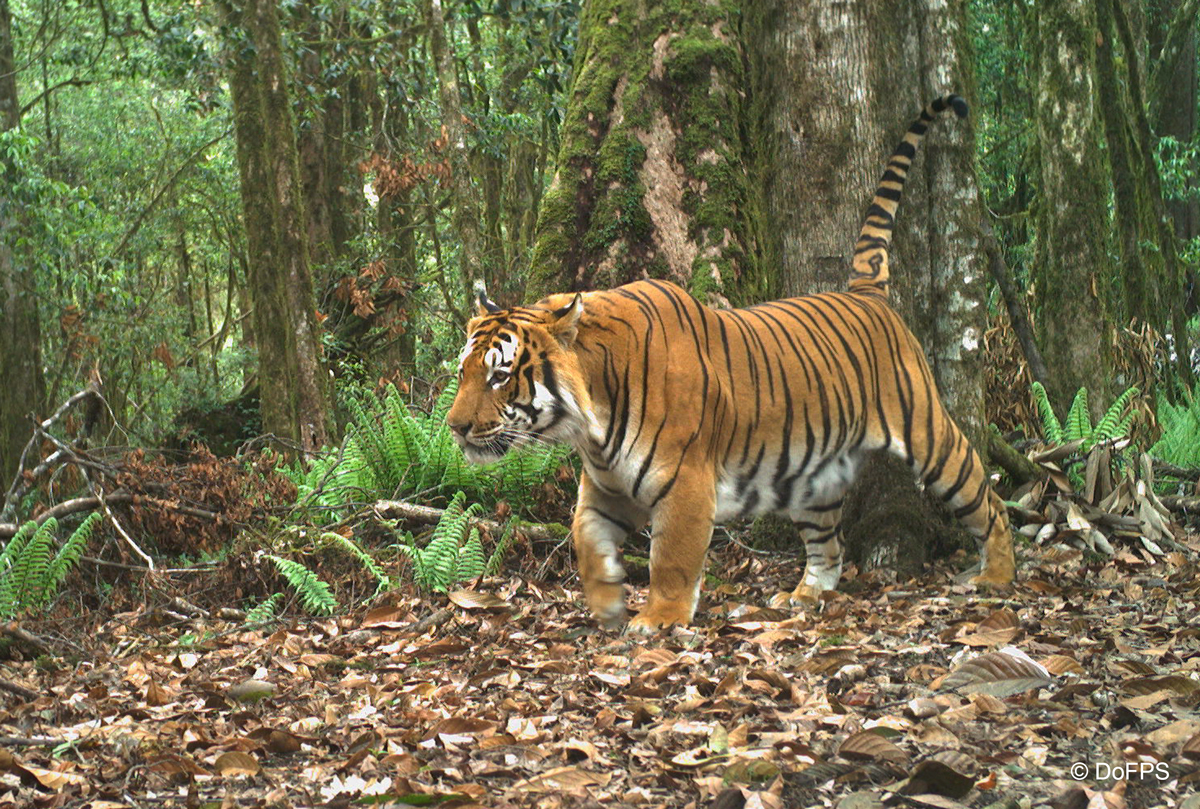The WWF is run at a local level by the following offices...
- WWF Global
- Adria
- Argentina
- Armenia
- AsiaPacific
- Australia
- Austria
- Azerbaijan
- Belgium
- Bhutan
- Bolivia
- Borneo
- Brazil
- Bulgaria
- Cambodia
- Cameroon
- Canada
- Caucasus
- Central African Republic
- Central America
- Central Asia
- Chile
- China
- Colombia
- Croatia
- Democratic Republic of the Congo
- Denmark
- Ecuador
- European Policy Office
- Finland
Establishing the Gewog Tiger Conservation Tshogpa
 |
| A camera trap photo of tiger in Bhutan. Bhutan endeavours to secure the future and population of wild tigers. |
The Gewog Tiger Conservation Tshogpa (GTCT) is a community-based initiative that was established to mitigate human-wildlife conflict, particularly human-tiger conflicts (HTCs), in Bhutan.
Over the past decade, Bhutan has faced increasing challenges relating to agricultural sustainability and wildlife conservation due to crop loss and predation of livestock by wild animals. Tigers have caused significant damage, with over 500 incidents of livestock being killed or injured having been reported in the Central Region alone over the past two years. The severity of HTCs is most pronounced in the Trongsa, Zhemgang, Wangdiphodrang, and Bumthang Dzongkhags.
Recognising the need for a comprehensive and coordinated approach to address human-wildlife conflict, the Department of Forests and Park Services (DoFPS) initiated the GTCT as part of its Safe System Approach. Initially implemented as a pilot project in six Gewogs – Nubi, Tangsibji, Langthel, Korphu, Nangkor, and Chumig – which span Trongsa, Zhemgang and Bumthang Dzongkhags, the GTCT aims to provide an integrated, community-driven solution to manage and mitigate HTCs.
Like the successful Gewog Environment Conservation Committee model, the GTCT is designed to be an integrated, site-based approach that promotes decentralised local governance and community ownership to managing and resolving HTCs at the grassroots level. By establishing an appropriate compensation mechanism, the GTCT aims to minimise financial losses incurred by local communities due to livestock depredation by tigers.
To ensure the effectiveness of the GTCT, a strong set of bylaws has been put in place, and mutually supporting actions are being implemented to prevent, mitigate, respond to, predict, and monitor HTCs. This holistic approach recognises the interconnectedness of the six key elements and emphasises that they should not be implemented in isolation. Lessons learned from the pilot implementation will inform future action and adaptations, ensuring the scalability and adaptability of the GTCT model to other human-wildlife conflict sites across Bhutan.
To enhance HTC reporting and response time, Tiger Quick Response Teams will be established in each GTCT site. These teams will play a crucial role in the swift and efficient management of any conflicts, thereby reducing potential risks to both human livelihoods and tiger populations. In addition to the six Gewogs covered under the pilot GTCT, a new GTCT is currently being established in Drakteng Gewog to ensure the effective long-term HTC management in that area.
Through WWF-Hong Kong support, GTCT has been established in one additional gewog - Drakteng and based on the successes and lessons learned, the government plans to upscale and replicate it in six additional gewogs - Dangchu, Goenshari, Khamae, Sephu, Jigmecholing and Phangkhar. These Gewogs span six Dzongkhags: Wangdue, Punakha, Trongsa, Gasa, Sarpang, and Zhemgang. This expansion will further mitigate HTCs in these areas and foster community engagement and support for long-term conservation efforts.
 |
 |
 |